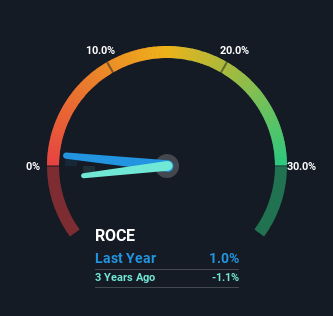- Hong Kong
- /
- Hospitality
- /
- SEHK:69
Some Investors May Be Worried About Shangri-La Asia's (HKG:69) Returns On Capital

What financial metrics can indicate to us that a company is maturing or even in decline? Businesses in decline often have two underlying trends, firstly, a declining return on capital employed (ROCE) and a declining base of capital employed. This combination can tell you that not only is the company investing less, it's earning less on what it does invest. Having said that, after a brief look, Shangri-La Asia (HKG:69) we aren't filled with optimism, but let's investigate further.
Return On Capital Employed (ROCE): What Is It?
If you haven't worked with ROCE before, it measures the 'return' (pre-tax profit) a company generates from capital employed in its business. Analysts use this formula to calculate it for Shangri-La Asia:
Return on Capital Employed = Earnings Before Interest and Tax (EBIT) ÷ (Total Assets - Current Liabilities)
0.0098 = US$108m ÷ (US$12b - US$1.4b) (Based on the trailing twelve months to June 2023).
Thus, Shangri-La Asia has an ROCE of 1.0%. In absolute terms, that's a low return and it also under-performs the Hospitality industry average of 4.4%.
See our latest analysis for Shangri-La Asia

Above you can see how the current ROCE for Shangri-La Asia compares to its prior returns on capital, but there's only so much you can tell from the past. If you'd like, you can check out the forecasts from the analysts covering Shangri-La Asia here for free.
How Are Returns Trending?
We are a bit worried about the trend of returns on capital at Shangri-La Asia. About five years ago, returns on capital were 2.1%, however they're now substantially lower than that as we saw above. And on the capital employed front, the business is utilizing roughly the same amount of capital as it was back then. Companies that exhibit these attributes tend to not be shrinking, but they can be mature and facing pressure on their margins from competition. If these trends continue, we wouldn't expect Shangri-La Asia to turn into a multi-bagger.
What We Can Learn From Shangri-La Asia's ROCE
In summary, it's unfortunate that Shangri-La Asia is generating lower returns from the same amount of capital. It should come as no surprise then that the stock has fallen 51% over the last five years, so it looks like investors are recognizing these changes. Unless there is a shift to a more positive trajectory in these metrics, we would look elsewhere.
If you'd like to know more about Shangri-La Asia, we've spotted 2 warning signs, and 1 of them is a bit concerning.
If you want to search for solid companies with great earnings, check out this free list of companies with good balance sheets and impressive returns on equity.
New: Manage All Your Stock Portfolios in One Place
We've created the ultimate portfolio companion for stock investors, and it's free.
• Connect an unlimited number of Portfolios and see your total in one currency
• Be alerted to new Warning Signs or Risks via email or mobile
• Track the Fair Value of your stocks
Have feedback on this article? Concerned about the content? Get in touch with us directly. Alternatively, email editorial-team (at) simplywallst.com.
This article by Simply Wall St is general in nature. We provide commentary based on historical data and analyst forecasts only using an unbiased methodology and our articles are not intended to be financial advice. It does not constitute a recommendation to buy or sell any stock, and does not take account of your objectives, or your financial situation. We aim to bring you long-term focused analysis driven by fundamental data. Note that our analysis may not factor in the latest price-sensitive company announcements or qualitative material. Simply Wall St has no position in any stocks mentioned.
About SEHK:69
Shangri-La Asia
An investment holding company, develops, owns/leases, operates, and manages hotels and associated properties worldwide.
Good value second-rate dividend payer.
Similar Companies
Market Insights
Community Narratives



